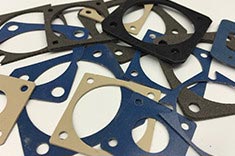EMI Shielding Products
- Custom Gasket Fabrication
- Connector Gaskets
- Bonded O Ring
- Custom Gaskets
- Conduct-O-Knit Knitted Wire Mesh
- Conduct-O-Seal Combo Gasket
- Conduct-O-Elastomer
- Conduct-O-Seal Oriented Wire in Silicone Gasket Material
- Conduct-O-Mesh Tape
- Conduct-O-Foam
- Conduct-O-Bond
- Optical Filters For Electronic Displays
- Shielded Vent Panels
- ESC Board Level Shielding
- 300 Series
Understanding the Role of Conductive Silicones in Shielding EMI

Regarding electromagnetic interference (EMI) shielding, conductive silicones have had a transformative impact. Typically loaded with metallic particles, these silicones resist environmental conditions while offering efficient EMI shielding. Despite their benefits, early particle-filled silicones were critiqued for their hardness, brittleness, and supposed inability to accommodate thin electronic designs. These factors, in combination with concerns over cost and limitations in part sizes based on mold dimensions, initially deterred their widespread adoption.
- Early particle-filled silicones faced criticism for their perceived hardness and brittleness.
- Concerns about part size limitations due to mold dimensions were prevalent.
- A misconception existed that all particle-filled silicones were unfit for thinner electronic designs.
- The high costs of early particle-filled silicones acted as a barrier to their use.
Challenges and Evolution in Conductive Silicone Materials
Constant innovation has addressed these issues, reinforcing conductive silicones as a powerful solution for EMI shielding. Silver aluminum, the former popular choice for filler material, posed challenges due to the fluctuating prices of silver. The substantial expense associated with pure silver-filled silicone EMI gaskets became particularly problematic.
- Silver aluminum was the preferred filler material due to its potent EMI shielding properties.
- The escalating price of silver necessitated the search for less expensive filler materials.
- The costliness of pure silver-filled silicone gaskets underscored the need for alternative solutions.
The Emergence of Cost-effective Alternatives for EMI Shielding
The industry today is ripe with affordable and effective alternatives. Silver copper, silver glass, and nickel graphite are used as particle fills. Nickel-graphite silicones perform on par with silver-aluminum and meet the EMI shielding effectiveness stipulated by MIL-DTL-83528, which mandates a minimum shielding effectiveness of 100 dB at RF frequencies between 20 and 10,000 Hz.
- Silver copper and silver glass are affordable alternatives to silver-aluminum currently in use.
- Nickel-graphite silicones offer a cost-effective and efficient solution.
- Nickel-graphite silicones comply with the rigorous EMI shielding requirements of MIL-DTL-83528.



